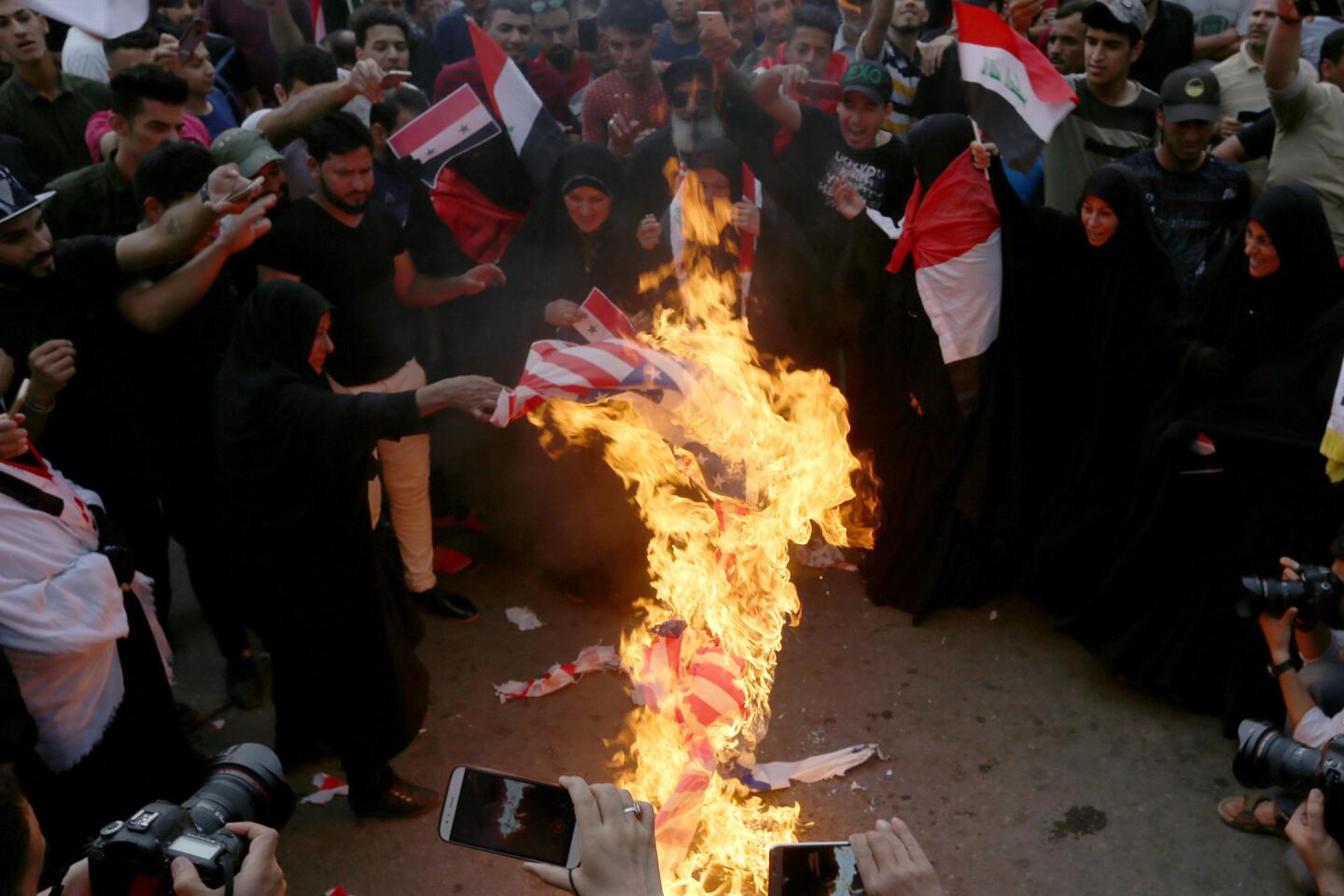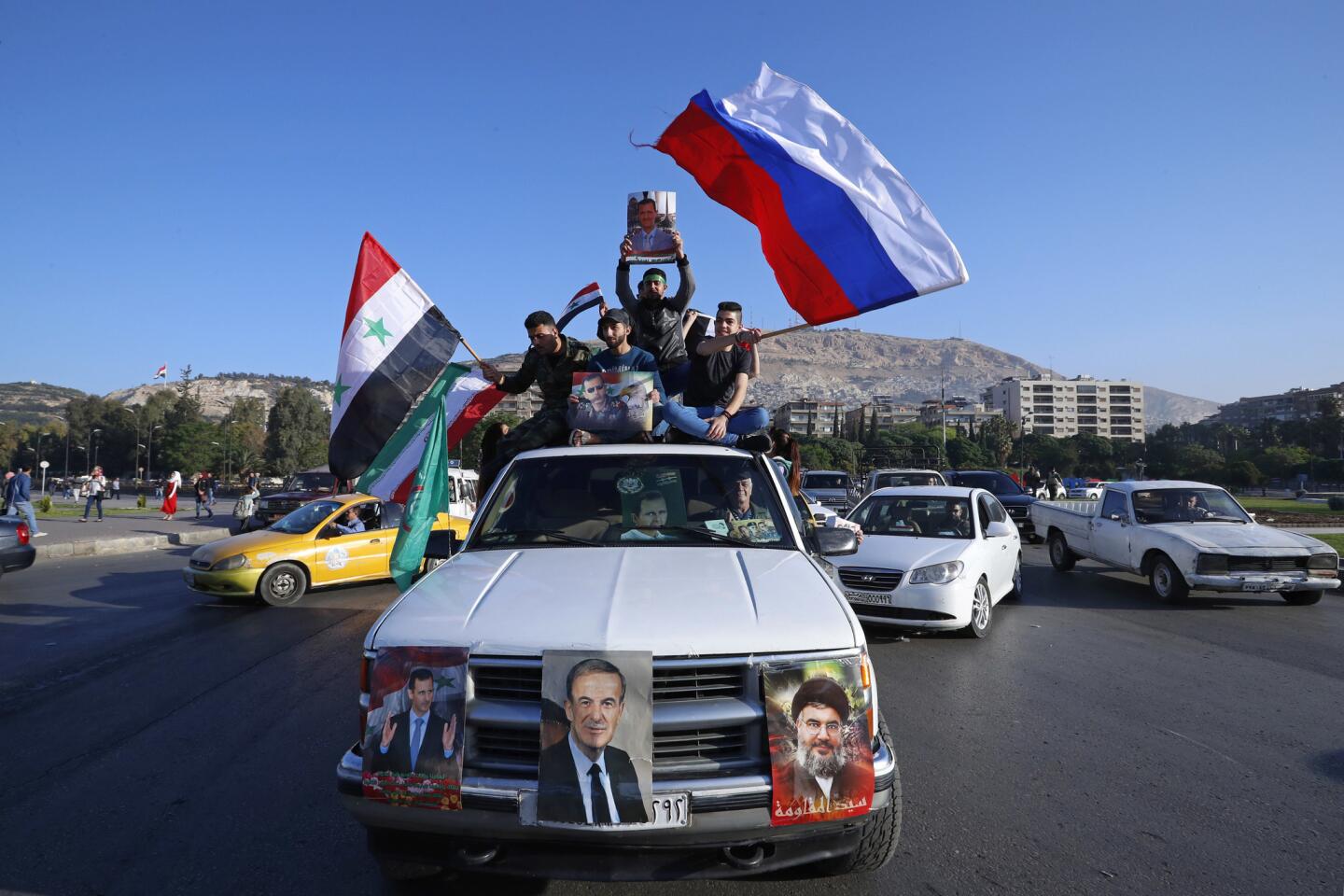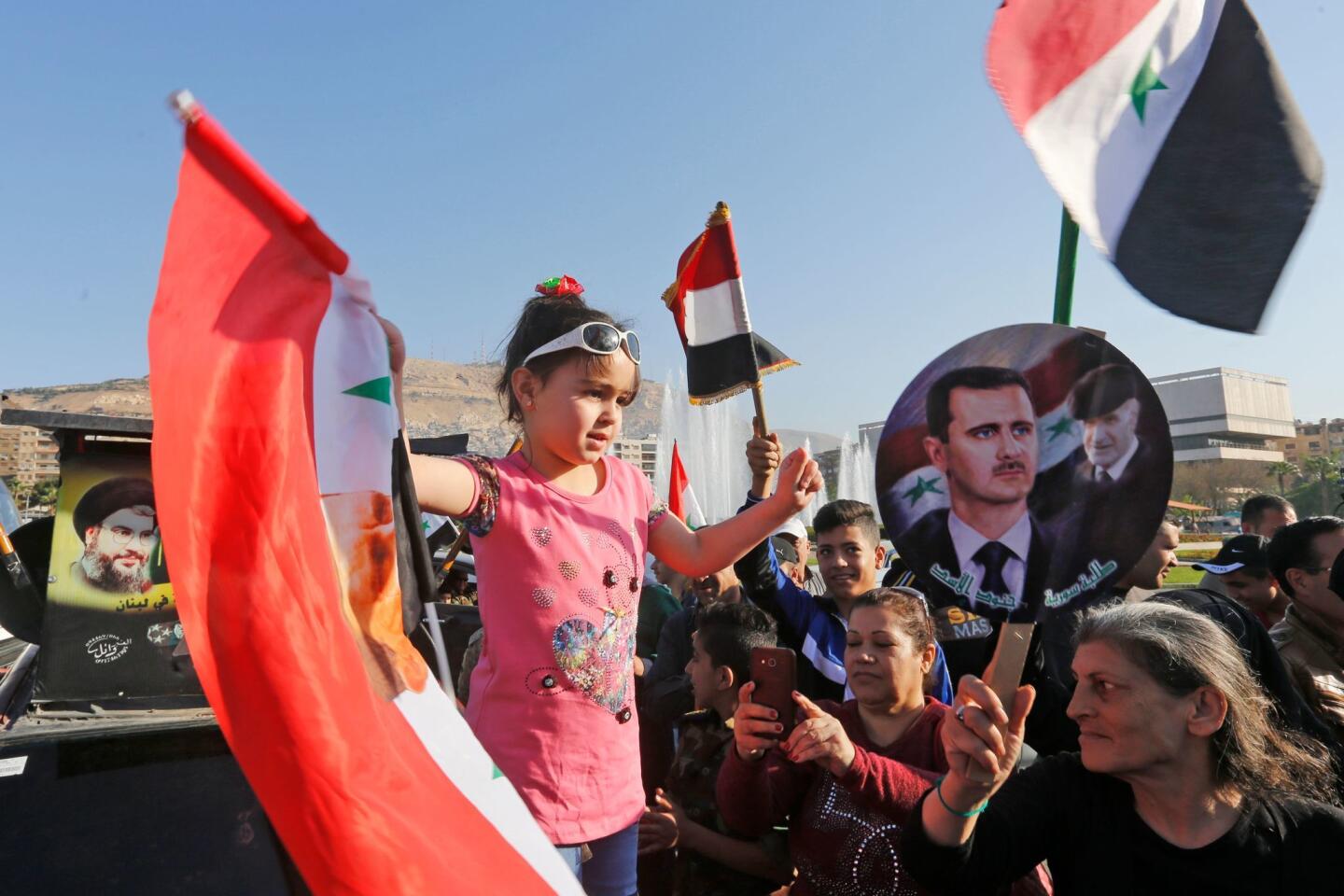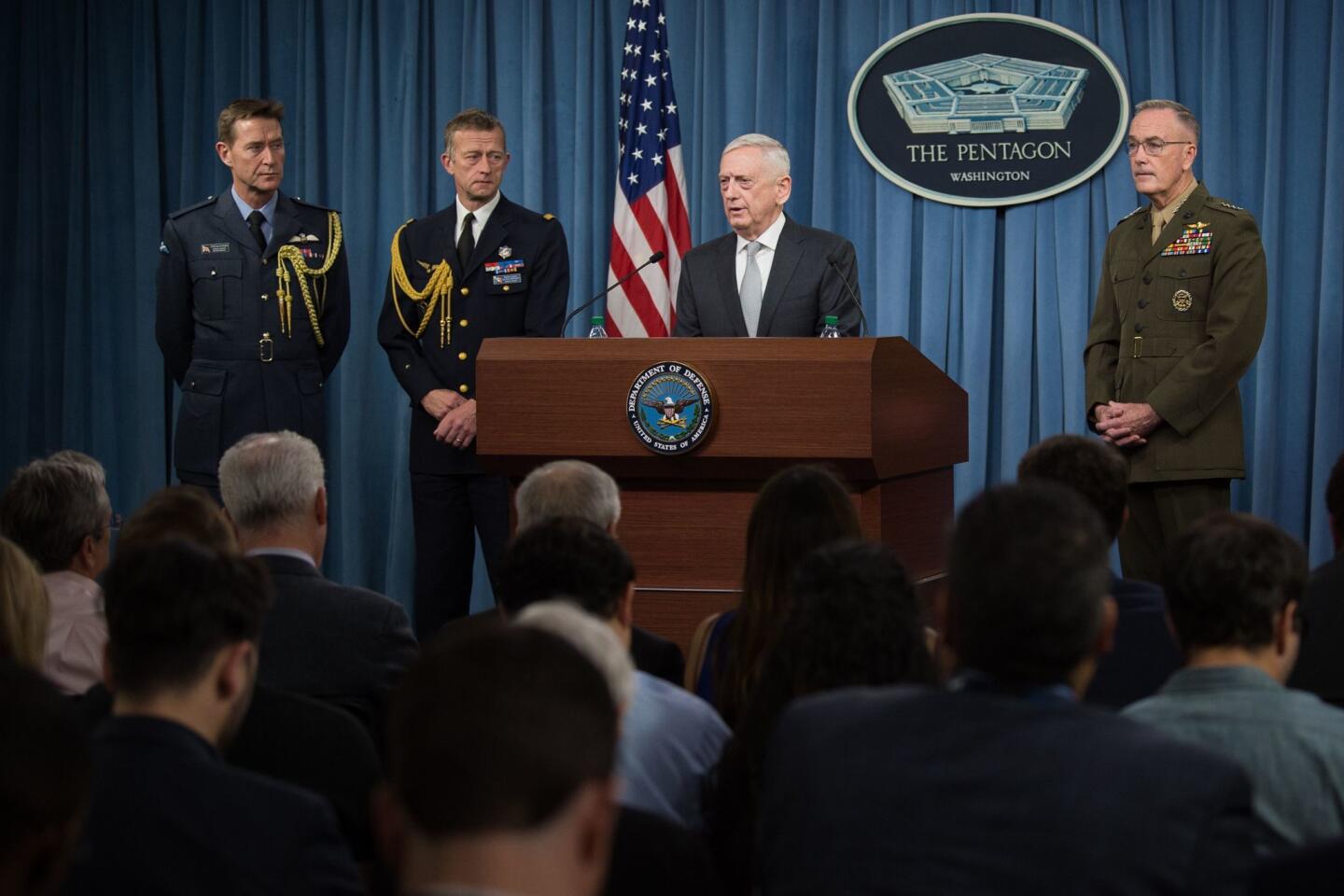Trump declares ‘Mission Accomplished!’ with Syria airstrikes as Assad holds on to power
- Share via
Reporting from Washington — President Trump declared “Mission Accomplished!” Saturday while the Pentagon said its initial assessment was that a powerful predawn missile barrage by the United States, Britain and France had “degraded” but may not have fully destroyed Syria’s chemical weapons stockpiles.
Nikki Haley, the U.S. ambassador to the United Nations, told an emergency session of the U.N. Security Council — the fifth in a week — that Trump was “locked and loaded” to order another punitive attack if Syrian President Bashar Assad uses chemical weapons again.
The Trump administration thus appeared to draw a new red line, suggesting that using even chlorine, which is not an illegal substance, would spark military reprisals.
The crisis seemed to quickly ease, however. Russia leveled scathing criticism at what it called a “military crime” and “acts of aggression,” but a Russian-drafted resolution of condemnation of the missile attack on Syria failed to pass the Security Council. Neither Moscow, Iran nor their armed proxies moved to retaliate against U.S. forces or interests.
Syrians said the rain of 105 missiles had caused no deaths or toxic chemical clouds, and hit only a handful of military facilities that the Trump administration said were used to research, produce or stockpile chemical and biological warfare agents.
The one-night show of force was not enough to shake Assad’s grip on power. Despite Trump’s bellicose threats last week, he made no attempt to decapitate the government in Damascus, or even to incapacitate its war-making ability.
Defense Secretary James N. Mattis had warned all week that a multi-day air campaign aimed at Syrian military command and control facilities, or its air defense systems, could pull Russia and Iran into a direct conflict with the U.S. — or pull the U.S. into another quicksand war in the Middle East.
Indeed, Trump’s “Mission Accomplished” tweet was an awkward — or taunting — reminder of the giant banner that famously served as a backdrop when President George W. Bush, wearing an aviator’s flight suit, stood on the deck of an aircraft carrier six weeks after the U.S.-led invasion of Iraq in 2003 and declared that major combat operations had ended.
America’s war in Iraq dragged on for eight more painful years, and the phrase haunted Bush as a symbol of the misjudgments and mistakes in a conflict that left 4,500 Americans and tens of thousands of Iraqis dead. The U.S. still has troops deployed in Iraq as well as Syria.
Trump spoke by phone with British Prime Minister Theresa May and French President Emmanuel Macron. They affirmed the joint airstrikes were successful and “necessary to deter Assad from any further use of chemical weapons,” the White House said.
Pentagon officials refused to say how they would respond if another deadly chlorine attack occurred, though they explicitly warned Moscow to restrain Assad and force him to live up to pledges to give up his chemical weapons stockpiles completely.
In this case, every missile launched Saturday struck its target and none was shot down by Syrian or Russian air defense systems, the Pentagon said. Nor were any attacking aircraft struck.
All of the coalition missiles were fired from warplanes or naval vessels in the Red Sea, Persian Gulf and eastern Mediterranean Sea, hundreds of miles from their targets and out of range of Syria’s antiaircraft batteries. The missile salvo hit almost simultaneously, within minutes of 4 a.m. local time, officials said.
The strategy of avoiding Syrian airspace and firing from multiple directions simultaneously was designed to confuse and overwhelm Syrian and Russian air defense systems.
Syria sent 40 air defense missiles streaking into the night sky, but only after all the U.S., French and British weapons had struck their targets, Marine Lt. Gen. Kenneth McKenzie Jr., director of the Pentagon’s Joint Staff, told reporters at the Pentagon.
“The Syrian response was remarkably ineffective,” McKenzie said. Russian forces in Syria fired no missiles, he added.
It wasn’t yet clear whether Syria had preemptively trucked away any of its chemical weapons or production equipment from the three facilities targeted by the U.S. — one near Damascus and two around the city of Homs — after Trump repeatedly warned in tweets last week that airstrikes were coming.
But McKenzie said Syrian forces could not have moved all the equipment and precursor chemicals necessary to produce nerve gas and other weaponized chemical agents.
“I believe that there was materiel and equipment associated with each of these sites that was not movable, and that’s what really sets them back,” he said. He said the installations that produced chlorine gas and sarin, a deadly nerve agent, were damaged or destroyed.
The goal of the strikes was “to cripple Syria’s ability to use chemical weapons in the future,” Pentagon spokeswoman Dana White told reporters.
“It was a deliberate decision to go to the storage facilities, to go to the research facilities,” she added. “We’re confident that we’ve significantly degraded his ability ever to use chemical weapons again.”
The largest and most important target was the Barzeh Research and Development Center near Damascus. U.S. officials described it as a key part of the Syrian chemical and biological weapons program.
The center was leveled by 57 cruise missiles fired by U.S. warships and submarines, and 19 long-range air-to-ground attack missiles fired from Air Force B-1 bombers, officials said.
Before-and-after pictures released by the Pentagon show three buildings and a parking garage collapsed and in rubble.
“They had three buildings there and a parking deck, and now they don’t,” McKenzie said.
British Tornado and Typhoon fighters fired long-range air-to-ground missiles at the Him-Shinshar chemical storage facility, west of Homs. The U.S. and French also hit the facility with multiple missiles.
“Our initial assessment is that this target was completely destroyed,”McKenzie said.
France targeted a nearby storage bunker where chemical and biological weapons were kept, hitting it with seven cruise missiles. McKenzie said the facility had been “successfully hit and sustained damage.”
Pentagon officials worried that the airstrikes might lead to an accidental release of toxic chemical agents. But they said highly accurate Tomahawk missiles mitigated the danger by striking the facilities and incinerating or destroying the contents. There were no reports of poison gas leaks.
The coordinated attack was launched in retaliation for a suspected poison gas attack on April 7 that killed at least 43 people during a government-backed offensive on Duma, a rebel-held bastion near the Syrian capital. Government troops later captured the area.
Citing circumstantial evidence, the Trump administration argued that sarin, a banned nerve agent, was probably mixed with chlorine in the Duma attack, although it doesn’t have ironclad evidence that sarin was used.
A senior administration official, who briefed reporters on condition of anonymity, said high-resolution photographs of victims in Duma showed them choking and foaming at the mouth, with constricted pupils and convulsions — symptoms of chemical poisoning, likely sarin.
The official also said that U.S. intelligence had tracked Syrian military helicopters above Duma before the attack and that they had dropped so-called barrel bombs, which Assad’s forces have used in the past for chemical agents. Victims and medical personnel reported a strong smell of chlorine and other chemicals.
Trump ordered a missile strike last April after a sarin attack killed dozens of people in Idlib province. U.S. warships fired 59 Tomahawk cruise missiles at a single Syrian airfield, careful to avoid suspected sarin stockpiles there.
But Assad continued to use chlorine gas against civilians over the past year, the White House said.
Analysts said the latest airstrikes, which used twice as many missiles, may stop Assad from using chemical weapons again. But he already has survived a civil war that has killed more than 400,000 Syrians, and appears within reach of consolidating his victory.
“These limited strikes may serve to deter future chemical weapons use, but assuming they don’t trigger escalation or a retaliation, they won’t dramatically alter the course of the conflict,” tweeted Emma Beals, a Beirut-based expert who has been monitoring the war.
Times staff writer Alexandra Zavis contributed to this report from Beirut.
Twitter: @davidcloudLAT
UPDATES:
4:40 p.m.: This article was updated with changes throughout.
This article was originally published at 11:35 a.m.
More to Read
Sign up for Essential California
The most important California stories and recommendations in your inbox every morning.
You may occasionally receive promotional content from the Los Angeles Times.




















